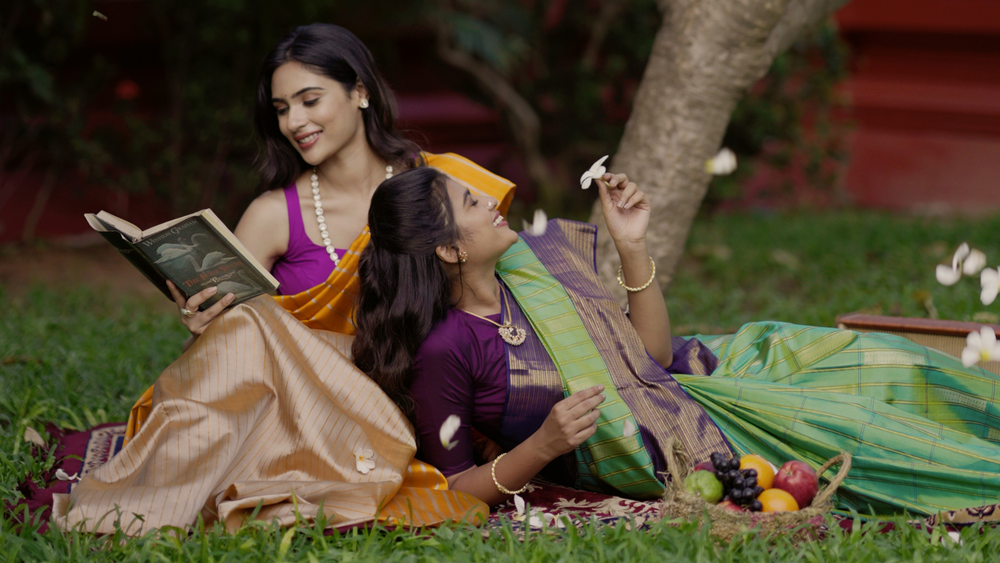The Temple Border: A Timeless Symbol of Tradition and Grace
The temple border is one of the most iconic designs in Kanjivaram sarees, inspired by the majestic gopurams—the grand gateways of Tamil Nadu’s temples. These structures are not just architectural wonders; they symbolize a bridge between the earthly and the divine, connecting the physical world to the spiritual realm.
Kanchipuram, known as the “City of Temples,” has been a center of devotion and craftsmanship for centuries. The town’s temples, with their intricate carvings, towering spires, and spiritual significance, have inspired generations of weavers. The temple border motif reflects this heritage, bringing the essence of these sacred structures into the weave of a saree.
While rooted in a singular inspiration—the majestic gopurams of Tamil temples—the temple border has evolved into multiple beautiful forms over time. Each variation carries its unique charm, reflecting different aspects of Tamil culture, devotion, and life. Let’s delve deeper into some of the most cherished types of temple borders:
Thazampoo Rekku
This Emerald Green Kanchivaram Silk Saree, adorned with the exquisite Thazham Poo border design, beautifully blends tradition and nature. The design draws inspiration from the Thazampoo, or screw pine flower, known for its sharp-edged, wide petals. The Thazampoo Rekku pattern embodies both strength and beauty, mirroring the flower’s elegance and resilience. The boldness of this border makes the saree a striking choice, reflecting the timeless appeal of nature while staying deeply rooted in traditional craftsmanship. The rich emerald green silk enhances the design's vibrancy, creating a saree that is as powerful as it is graceful.
Pillayar Moggu
This saree features a pear green body with a contrasting magenta border and an orange selvedge, adorned with the Pillaiyar Moggu motif. Named after Lord Ganesha, fondly called Pillayar in Tamil, this motif carries a softer aesthetic, with its rounded shapes resembling buds about to bloom. It symbolizes new beginnings, prosperity, and divine blessings. The design’s simplicity and spiritual significance make it particularly cherished, embodying grace and meaning for those who hold these qualities dear in their sarees. The combination of vibrant colors with this auspicious motif makes this saree a beautiful expression of elegance and devotion.
Seepu Rekku
This Shades of Blue and Green, And Pink Traditional Kanjivaram Silk Saree is a stunning blend of lovely shades, highlighted with intricate silver and gold zari work that brings a touch of sophistication. The contrasting pink border and pallu are adorned with the traditional Seepu Rekku border, meaning "comb-like border" in Tamil. This delicate striped pattern, with its tapering lines and even spacing, adds to the saree’s understated beauty. Known for its balanced and slender lines, the Seepu Rekku signifies order and harmony, deeply rooted in Tamil traditions and lifestyle, elevating the entire piece to an epitome of timeless elegance.
Though these variations differ in form and meaning, they are all deeply connected to Tamil Nadu’s rich temple architecture. The triangular shapes, inspired by temple spires, continue to symbolize the spiritual connection between the human and the divine. Each design is a testament to the creativity and devotion of Kanchipuram’s weavers, who bring life to these motifs with skill and care.
By weaving these temple border designs into a saree, the artisans of Kanchipuram ensure that every piece carries the essence of Tamil heritage—celebrating the culture, spirituality, and craftsmanship that define this timeless tradition.
At Pashudh, we honor this cherished tradition, crafting sarees that celebrate the timeless beauty of temple borders. Each saree is a piece of heritage, woven with devotion and steeped in history.






Leave a comment